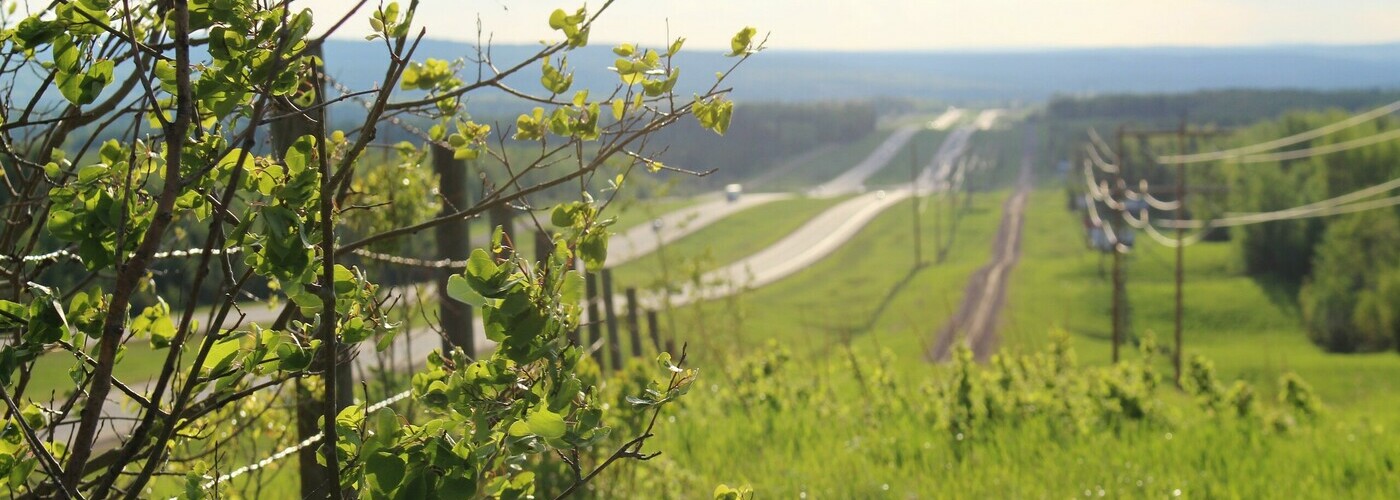In this section
As a community surrounded by forests, wildlife sightings are not uncommon; however, residents are advised to use caution when using the trail system and other outdoor recreation facilities as bears, cougars, moose and coyotes live in the forests in and around our community.
- Residents are reminded to keep their dogs on leashes and to be mindful of surroundings when walking area trails.
- Property owners are also encouraged to clean up yard waste (i.e. fruit that may have fallen off trees) and ensure garbage is not left out to help prevent wildlife encounters.
Wildlife sightings can be reported to Alberta Fish & Wildlife at 1-800-642-3800. For more information, visit the Government of Alberta’s website.
The Town of Whitecourt is working to control Black Knot within the Town’s parks, boulevards, and public spaces. Black Knot is highly infectious, and we appreciate the cooperation and support of commercial and residential property owners in helping control its spread.
What is Black Knot?
Black Knot is recognized by clumpy-looking, black masses of abnormal growths on the branches of trees. This fungal condition infects only Prunus species of plants (i.e. Mayday, Cherry and Plum trees). These trees are found in yards, boulevards, and parks throughout Whitecourt.
This disease reduces the look of the tree, as infections spread rapidly, and ultimately leads to eventual death of the plant.
Black Knot is highly infectious and spores can be carried by wind and rain, as well as wildlife. Removing infected branches/trees will help to control the spread of Black Knot within your property, your neighbour’s property, and the community.
How to Control Black Knot:
Prune out all knot-bearing branches during late fall/winter, or early spring when plants are dormant and knots are easy to see.
-
Remove infected branches to at least 15-20 centimetres (6-8 inches) below knot. NOTE: It is preferable to prune an infected branch further back to an appropriate location, such as a healthy collar, rather than leave a stub.
-
As a precaution, cutting blades should be cleaned and disinfected after each pruning cut, if possible, especially if cuts have been made through obviously infected material.
-
For knots on scaffold branches or trunks that can’t be removed, cut away diseased tissue down to good wood and at least 1 centimetre (1/2 inch) beyond the edge of the knot.
-
Failure to remove branches beyond the internal growth will result in re-growth of the fungus.
-
DISEASED WOOD MUST BE DESTROYED IMMEDIATELY (burned, buried, or removed from site and disposed of at the landfill). Diseased knots can produce and release spores for up to 4 months after removal.
-
When disposing of infected wood at the Whitecourt Regional Landfill, please inform staff upon entry so that you can be directed to the proper disposal area.
-
Consider hiring a trained professional for pruning activities.
Do you have questions about black knot? Contact the Town of Whitecourt at 780-778-2273.
In order to maintain the enjoyment and safety of users at Festival Park, and to lessen the impact geese have on the park environment, the Town of Whitecourt will be employing goose deterrent activities throughout the spring season annually. The initiatives will be undertaken in partnership with a Wildlife Control Officer and will utilize a variety of techniques, including strobe lighting, distress signals, decoys, and canine patrols.
Mountain pine beetles pose a significant threat to Alberta’s pine forests. Once attacked, healthy pine trees can die within one year.
Albertans play an important role in managing the mountain pine beetle infestation in the province. Albertans should monitor pine trees on their property and remove any mountain pine beetle infested pine trees.
Early detection and control is critical in managing infestations and preventing further spread.
Mountain Pine Beetle - What are the signs?
- Fine sawdust at the base of the tree and in the bark crevices;
- Increased woodpecker activity (holes in trees, flaked off bark);
- Grayish-blue wood.
For more information visit the Alberta Agriculture & Forestry website.
Please note that local bylaw enforcement does not have the responsibility or authority to control wildlife, such as skunks. If you have concerns regarding live animals, you’re encouraged to a pest control company for trapping/removal.
Skunks are no cause for alarm and play an important role in the eco-system. In the fall, skunks are busy eating and building up fat reserves for winter dormancy. They eat a lot of grubs and other harmful insects, fallen fruit, and garbage. Aside from the smell if agitated, skunks are a relatively harmless. That being said, they can be a nuisance, especially for dog owners.
Here are some tips to help prevent skunks from moving into your property
- Keep pet food or water inside overnight.
- Keep garbage/organics bins tightly closed.
- Clean and tidy yards.
- Remove items such as trash, loose lumber piles, and old vehicles where skunks could use for shelter.
- Fully seal off all openings around and under buildings and mobile homes.
- Use chicken wire around the bottom of decks or on the ground to prevent burrowing.
- Bright lights or mothballs may cause a skunk to leave from under steps or a building.
Alberta Environment and Parks has some great information on skunks.
Whitecourt carries out an annual program to control weeds in parks and open spaces. The goal is to control noxious weeds, provide safe and healthy turf, and protect trees and shrubs.
Control measures include mechanical trimming, removal of weeds by hand, and the application of herbicide.
All herbicides have been approved by Health Canada, Pest Management Regulatory Agency and Alberta Government, and will be applied under the supervision of workers who are provincially licensed. Herbicide application will be used during the day or early morning when the winds are generally light. The times and dates of treatment will depend on weather. Signs will be posted at major public entrances and surrounding treated areas; members of the public are asked to obey all posted signs and barricades.
